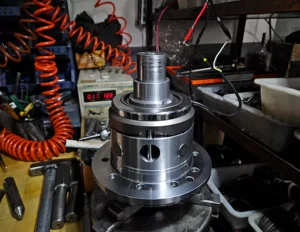The Haldex differential is a key component in many modern all-wheel-drive (AWD) vehicles, providing an intelligent and efficient way to manage power distribution between the front and rear wheels. Developed by the Swedish company Haldex Traction AB, this system is often referred to as the Haldex Coupling, though its role is integrally linked to the vehicle’s drivetrain and differential system. Here’s an in-depth look at what makes the Haldex differential unique and why it’s so widely used.

How Does the Haldex Differential Work?
At its core, the Haldex system is an electronically controlled, hydraulically actuated coupling device that connects the front and rear axles. Its primary function is to dynamically distribute torque between these axles based on real-time driving conditions.
Core Components and Mechanism
- Hydraulic Pump: Detects rotational speed differences between the front and rear axles.
- Control Unit: Monitors inputs such as wheel speed, throttle position, and steering angle to determine how much torque should be transferred.
- Clutch Pack: Engages or disengages to transmit torque as needed.
The system operates in on-demand AWD mode, meaning it predominantly powers one axle (typically the front) and only sends torque to the other axle when slip or traction loss is detected.
Advantages of the Haldex Differential
The Haldex system offers several advantages, making it a preferred choice for many manufacturers and vehicle owners:
Efficiency and Fuel Economy
Unlike full-time AWD systems, the Haldex differential only engages the rear axle when necessary. This significantly improves fuel efficiency by reducing energy loss during normal driving conditions.
Intelligent Torque Distribution
The system reacts quickly to changes in traction, providing immediate power to the wheels that need it most. This makes it highly effective on slippery roads or during light off-roading.
Compact Design
Haldex differentials are compact and lightweight, making them suitable for smaller vehicles or those built on front-wheel-drive platforms.
Versatility
Haldex technology is versatile and has been adapted for use in passenger cars, SUVs, and even performance-oriented vehicles.
Applications of Haldex Differentials
The Haldex system is commonly found in vehicles from the Volkswagen Group, including Audi, Volkswagen, SEAT, and Škoda. It’s also used in other manufacturers’ models, such as Volvo and Land Rover.
Examples of Vehicles with Haldex:
- Audi A3 Quattro
- Volkswagen Tiguan 4Motion
- Land Rover Freelander
- Volvo XC60
These vehicles benefit from the balance of AWD capability and efficiency that the Haldex system offers.
Conclusion
The Haldex differential represents a milestone in drivetrain technology, combining the benefits of AWD with the efficiency of a front-wheel-drive system. It’s an excellent solution for drivers who need occasional AWD capability without the fuel consumption or weight penalties of full-time AWD systems.
Whether you’re driving in snowy conditions, navigating wet roads, or simply enjoying the extra confidence an AWD system provides, the Haldex differential ensures a safe and efficient driving experience. It’s a testament to how smart engineering can enhance both performance and practicality in modern vehicles.



